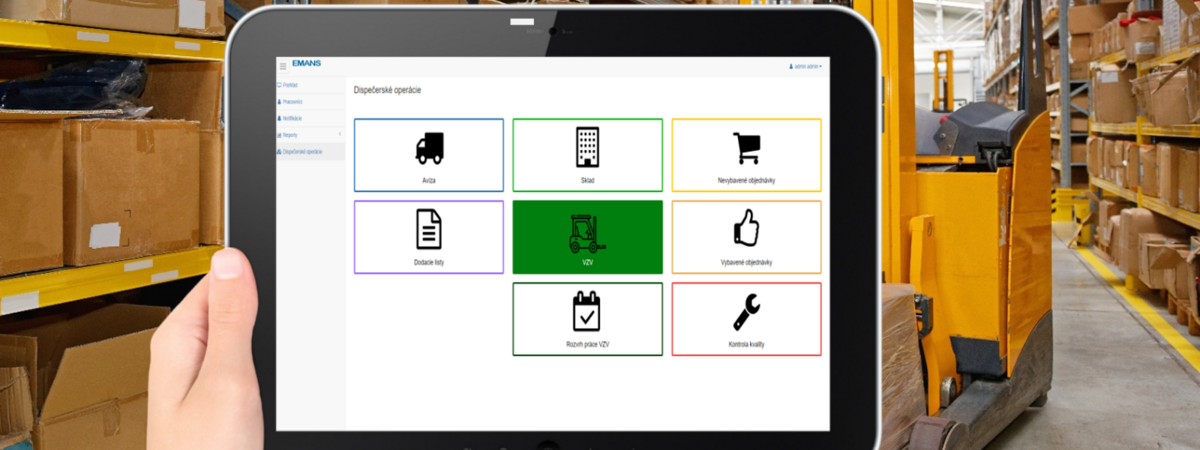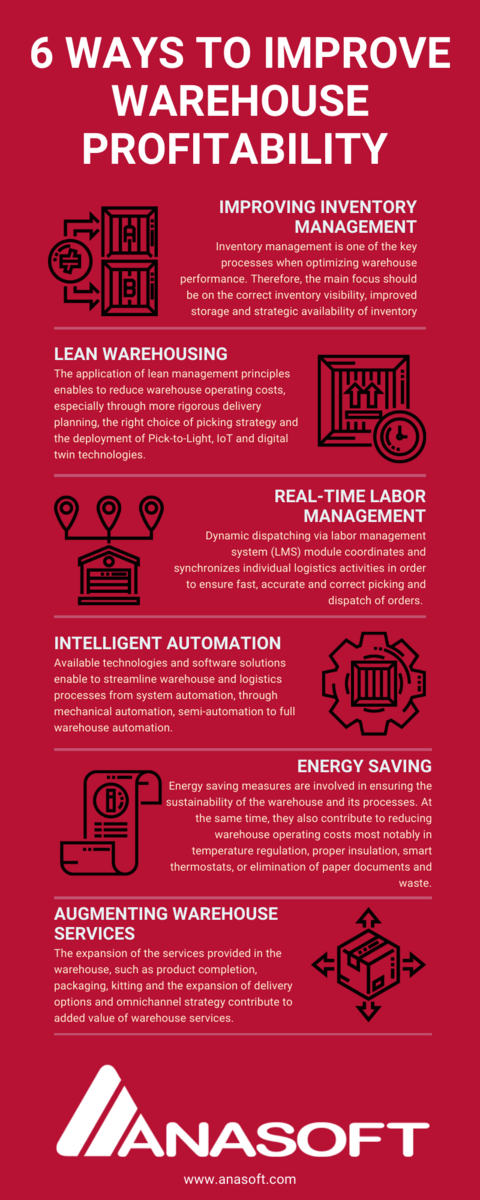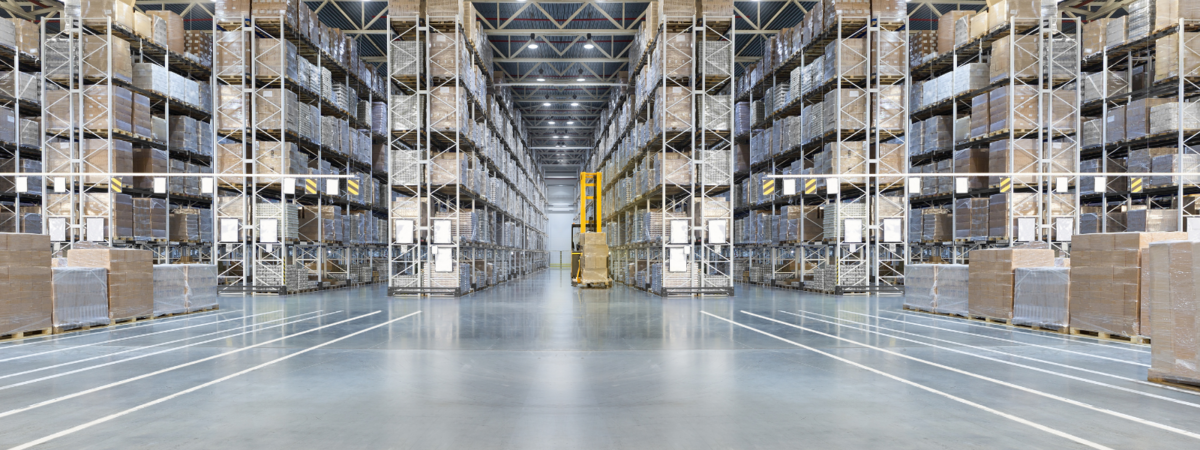6 Ways to Improve Warehouse Profitability and Efficiency
2021-09-27
We’ve laid out six ways how you can increase warehouse profitability, reduce its operating costs, and improve warehouse performance.
Warehouse providers and distribution companies have come under great market pressure due to the global crisis. Rising demand and the rapid development of online shopping have fuelled the expansion of the competitive environment in retail and beyond. For warehouse providers, the question of whether to increase investment budgets for modernization (and automation) or not has come under consideration. This makes cost optimization a challenge for every distribution center, shop floor, and business.
Since investing a significant amount of a company´s budget is a gargantuan task, retailers and enterprises have started to look for ways to improve the performance of warehouses, distribution centers, and supply chains without increasing investment budgets or operating costs significantly. Instead of spending their reserves on large-scale digital transformation and automation projects to improve warehouse performance, businesses have counted on less financially demanding solutions and options that are available to help optimize operating costs and boost the performance of logistics processes at the same time.
IMPROVING INVENTORY MANAGEMENT
The first steps in increasing warehouse profitability should focus on inventory management methods. Inventory management is also one of the key processes to be optimized if a business is striving to achieve better warehouse productivity.
a) Inventory Visibility
Inventory visibility is one of the basic features of a warehouse that has a direct effect on increasing the efficiency of order picking. Correct and accurate visibility of inventory means knowing what types of stock-keeping units (SKUs) are located at what positions and in what quantities, thus eliminating unnecessary downtime and preventing picking up wrong SKUs.
Precise monitoring reflecting the actual state of inventory allows the warehouse to maintain the correct levels of SKUs. Furthermore, historical warehouse data can be processed for more accurate inventory planning and sales forecasting which helps to avoid overstocking or missing items due to inventory understocks.
b) Storage Optimization
Storage methods are facing new challenges, especially to ensure the greatest possible flexibility of storage and picking processes. Appropriate storage optimization saves space, time and resources, while also contributing to curtailing errors in order picking.
Maximization of warehouse space utilization can be achieved by:
- vertical expansion of storage capacity (additional racking),
- installing a mezzanine floor,
- narrowing of aisles in shelving zones,
- or, the use of a cross-dock.
c) Strategic Inventory Availability
Given the increased flexibility and speed of order picking operations and cost optimization, storage of inventory in fixed positions is gradually becoming outdated. This is one of the reasons why businesses are starting to prefer demand-driven dynamic slotting and real-time inventory restocking based on actual SKU turnover concerning specific types of items (for example, during seasonal peaks or promo campaigns).
Dynamic slotting increases the strategic availability of stock. Furthermore, the dynamic slotting leads to:
- avoiding the creation of bottlenecks,
- shortening order picking cycles,
- and ultimately, reducing the general cost of picking orders.
As order picking can amount to up to 50% of total warehouse operating costs, storage optimization and dynamic slotting can make a significant contribution to reducing the budget to run a warehouse in the long run.
lean WAREHOUSING
Warehouse management entails a large number of processes and operations, including order and inventory management. If the sequence of these operations is not properly timed and synced, the following will occur:
- excessive duplication of warehousing operations,
- downtime in different parts of the warehouse,
- reduced quality of order picking.
That is why businesses are stepping forward to revise individual warehousing processes, including optimization and fine-tuning of warehouse logistics by applying the principles of lean management. The streamlining of warehouse processes can start with implementing more precise delivery planning. This contributes to curtailing bottlenecks and avoiding overburdening of staff employees working on inventory receiving processes.
Furthermore, the performance of inventory storing can be improved by real-time task allocation upon receiving the goods. Moreover, these methods can be applied to other warehouse management processes including:
- inventory receiving,
- repacking,
- put-away,
- storage,
- order picking,
- order completion,
- order dispatch.
Utilizing different picking strategies can optimize the order picking process determined upon:
- type of operation,
- inventory turnover,
- order volumes among other parameters.
A variety of picking strategies can be combined for different types of inventory or storing zone thanks to advanced warehouse management systems. Adequately matched picking strategy expands the throughput of the warehouse and maximizes the picking potential of a distribution center. In these cases, the deployment of a WMS / WES system is necessary.
The streamlining of warehousing processes can be also achieved by minor adjustments such as:
- storing the SKUs, which are most often picked together, in each other´s proximity,
- storing fast-moving stock horizontally,
- holding slow-moving stock vertically.
The order picking process can be further accelerated via voice picking technologies, more traditional Pick-to-Light systems, or moving items utilizing automated conveyors and carousels.
The streamlining of warehousing can be also approached holistically by deploying intelligent management of labor, inventory, and material handling equipment. Such a project requires a thorough audit of current processes and the preparation of a solution for real-time process management. In the case of larger automation projects, technologies such as IoT, digital twins, machine learning can be implemented to boost the overall performance. These technologies are usually already integrated into advanced warehouse management systems such as WES systems.
REAL-TIME LABOR MANAGEMENT
With the growing demands to strengthen the resilience of supply chains, standards of warehouse management are equally evolving. Labor management in warehouses has shifted from planning and scheduling shifts and prioritizing work tasks, to automation of task assignment management.
Effective allocation of task assignments based on parameters of the expected volume of orders, order structure, and delivery priorities nowadays is assimilated into dynamic task assignments dispatching. This functionality is most often part of LMS (Labor Management System) systems or their modules integrated into more advanced WMS/WES systems.
LMS allocates job assignments (inventory put away, order picking, order repacking, order dispatching) to employees in real-time based on their availability and order priority. This is one of the reasons why LMS significantly streamlines work management and maximizes the individual performance of warehouse staff, and not solely pickers. In addition to the operational dispatching function, the LMS takes into account other activities that need to be performed within the sequence of ongoing warehouse processes and operations when coordinating all planned job assignments.
This feature assures a smooth synchronization of order picking and other associated or follow-up jobs leading to quick, smooth, and correct dispatching of orders. With well-tuned algorithms and the deployment of innovative technologies such as digital twins, a business can achieve an equivalent of an in-plant Just-in-Time operational strategy for managing and synchronizing jobs and augmenting the operational performance of a distribution center.
A significant benefit of LMS is ensuring a balanced workload of employees. This feature assures that staff is working comfortably and ergonomically while observing occupational health and safety standards. At the same time, LMS´s job assignment management eliminates downtime and excessive traveling, as well as errors and misunderstandings when handling inventory or completing customer orders. This nifty feature ensures no employee remains idle.
As the LMS allows monitoring the performance of individual employees in real-time, a concept of gamification (deployment of game elements in a non-gaming environment) can be implemented into warehouse processes to further enhance staff productivity. Gamification aspects drive employees to healthy competition. Warehouse staff can have access to a leaderboard, which continuously updates the ranks of who has picked up the most orders on a particular shift or who is one of the most productive employees in that sense.
This gives employees access to immediate performance evaluation, which increases the transparency of the work environment and prevents deterioration of the social climate. On the other hand, managers can use this data to allocate performance bonuses equitably. This idea of promoting healthy competition between teams does not only promote a great working environment for the employees but also boosts overall productivity significantly.

INTELLIGENT AUTOMATION
Warehouses and distribution centers are among the environments where the degree of automation is proceeding rapidly due to the ever-changing demand of markets for goods and services. Available technologies and software solutions make it possible to optimize selected warehouse management processes from the partial automation of manual work to the deployment of an extensive automation project. There are many ways and solutions to automate distribution center operations ranging from system automation, mechanical automation, semi-automation to complete warehouse automation.
However, a business can begin with less demanding projects starting with the introduction of mobile scanning devices. These devices can improve the productivity of order picking processes while eliminating errors in order management and dispatch. Businesses can also proceed to the deployment of so-called island solutions focused on the automation of one type of activity at a single spot or zone, which can be sorting or (re)packaging of finalization of orders. For more advanced projects, separate islands of automation can be interconnected to advance the scaling of intelligent operations management.
In addition to improving the performance, automation is another way to optimize warehouse operating costs, ensure the sustainability of processes, and thus retain the competitive advantage of the business. The return on investment (ROI) depends on the scope of the automation project and the technologies that the company plans to install in the warehouse. By properly aligning the automation project with business goals and plans, the automation will allow the business to maximize returns and thus accelerate the increase in the overall profitability of a warehouse or a distribution center.
One of the strategies for adapting the operating model to the business model can be to replace the ERP/WMS system for warehouse and inventory management with a more complex WES management system. The WES system has wider functionality, including real-time inventory, work and equipment management, as well as dynamic scaling. Thanks to dynamic scaling, the system promptly and automatically adapts the management of warehouse logistics to current market requirements (for example during the season or in the case of crisis management).
In addition to WMS and LMS functionality, advanced WES systems also contain Warehouse Control System (WCS) functionality. WCS systems provide automated material flow control with warehouse technologies and material handling equipment (conveyor belts, sorters, digital scales, etc.).
ENERGY SAVING
Warehouse operators are aware of carbon reduction and green initiatives. That is why they are working towards applying energy-saving measures, which help to trim warehouse operating costs. The basic measures revolve around temperature control, in particular:
- warehouse insulation,
- ensuring proper closing of doors,
- if necessary, the installation of devices for automatic door closing.
For more efficient temperature control in the warehouse, partitions may be installed to divide warehouse space into several separate zones that can be heated or cooled independently and when needed. Another solution is the installation of smart thermostats to regulate the temperature based on actual needs.
The next area of cost optimization in warehouses is lighting. Companies can ensure that only zones, corridors, or aisles where necessary work is being carried out are using motion sensors to automatically control the lights.
The concept of eco-warehouse belongs to green initiatives related to saving energy and minimizing CO2 production. In addition to the elimination of waste and unnecessary packaging material, businesses are gradually shifting to a complete digitalization of paper documents, achieving paperless working environments. This can be also achieved with WMS / WES systems.
Other sustainability measures include the installation of solar panels on the roof of the warehouse or the use of energy from renewable sources. As part of sustainability strategies and the deployment of green technologies, the "net-zero" concept is starting to take off. This means that the warehouse building generates only as much energy as it needs to consume for its operation.

AUGMENTING WAREHOUSE SERVICES AND DELIVERY OPTIONS
Another way to increase the profitability of a warehouse is to expand delivery options. Due to current trends and expectations of customers, single-channel logistics is becoming more of a rarity. Multi-channel sales have already become a norm, while companies deploying omnichannel sales are gaining a bigger competitive advantage.
Servicing several sales channels simultaneously necessities the extension of order delivery, pick-up, and return options. These demands will prompt the transformation of warehouses capable of multi- or omnichannel logistics, which is quickly becoming a standard for retail, wholesale, and e-commerce.
Warehouses in manufacturing industries also have opportunities to increase their profitability by offering additional services beyond the conventional portfolio. Quality control of incoming materials and soon-to-be dispatched goods is progressively becoming a part of warehouse management, but also another value-added service such as:
- assembly and finalization of products,
- kitting and packaging,
- repackaging and preparation of special packaging designs (for example for seasonal or special promotional campaigns).
Some warehouse operators and logistics service providers (3PLs) are even offering specialized services such as ironing, technical testing, or calibrations of electronic devices directly in their warehouses and distribution centers.










